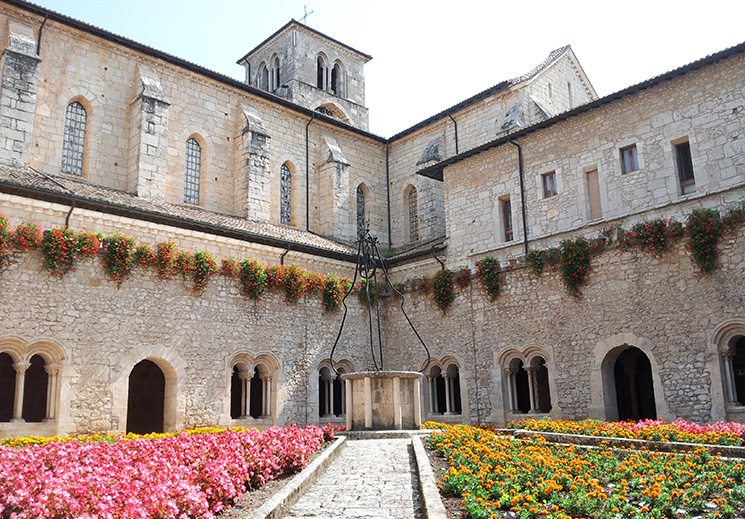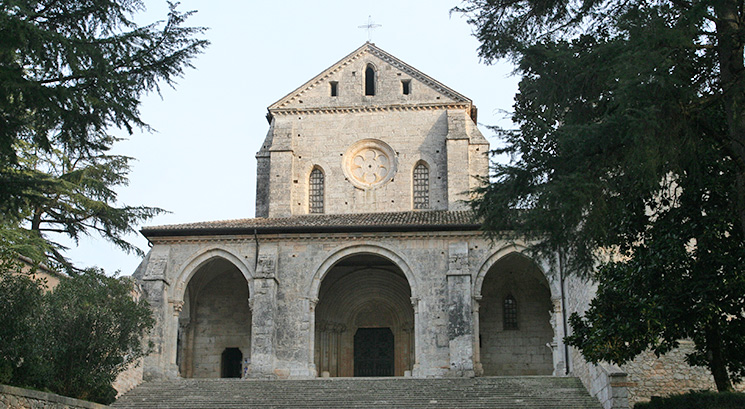The Abbey of Casamari

The Abbey of Casamari was founded at the beginning of the 11th century on the initiative of a small community of Benedictine Monks,who built the first monastery in the ancient municipium of Ceretae Marianae, Gaius Marius's birthplace. The Abbey passed to the Cistercians in 1152, when this order of monks spread throughout Italy thanks to the work of Bernard of Clairvaux and the support of the Popes. In 1203, they started a radical reconstruction of the old monastery following the typical planimetry of their order, under the direction and planning of Fra' Guglielmo from Milan. The Abbey of Casamari represents in the history of architecture a stylistic cornerstone of the arrival in Latium of the Gothic-Burgundian style at the beginning of the 13th century.
Right from the great entrance arch, surmounted by an open gallery with four mullioned windows (the Guest-Rooms), it is possible to see the façade of the church with its wide stairsflight and the three-arched atrium. The Roman columns, lined up along the path, add to the nobility and solemnity of the whole. The square Cloister with its sixteen mullioned windows, surrounded by porches, is the centre of the monastic life. Around the cloister there are the Church, immersed in a dim light that penetrates from its windows and its rose window; the Chapter House in which is more evident the original Cistercian architecture and the Refectory (the old larder) with its mighty cylindrical columns. Inside the church, the monumental Choir was made by Vincenzo Domenico De Donatis from Sora (1886-1969) and his sons. In the abbey there are also a Library and a Museum-gallery with works by Guercino, the Carracci brothers and Solimena. In the museum there is archaeological material too. By the entrance, in the attached Pharmacy, it is possible to find spirits distilled by the monks.
In the Basilica of S.Sàlome, between the Caduti side chapel and the semicircular stair leading to the Crypt of the Innocenti, the diocesan Bishop Lorenzo Tartagni had the Holy Stairway built. On the 30th June, 1715 pope Benedict XIV granted it the same privilege of the more famous Holy Stairway of St.John Lateran in Rome. It is made up of two little lateral entry stairs and, in the wider central part, there is a short gallery with a panelled ceiling hanging over the twelve steps of main stair made of local stone. On the back wall of the central little chapel, there is a canvas featuring The Deposition from the Cross by Antonio Cavallucci from Sermoneta (1752-1795); under it has been placed the relic of the Holy Cross.
The memorial stones hanging over the two lateral entrances, written in Latin and Italian, tell about the very rare privilege of the sacred place: "By concession of Pope Benedict XIV, going up this staircase kneeling, you can gain the daily indulgence for one hundred days and - once a month - perpetually, the same plenary indulgence of the Holy Staiway in Rome". The same privilege of plenary indulgence, as reminded by the two memorial stones on both sides of the Basilica’s entrance, can be obtained underparticular conditions, by all the people who, every year on the 24th and 25th May (the solemn liturgy of the transfer of St. Sàlome's body), pray by the Confessional of the church, where the relics of the Saint are worshipped.
